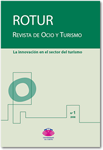Innovation in the Basque tourism activity: towards a competitive model in the A.C. of Euskadi
Main Article Content
Abstract
Within a global framework of increasing economic weight of the tourism industry, the data show that the evolution of the tourism industry in the Autonomous Community of Euskadi follows a path of sustained growth, which, nevertheless, is marked by a progressive change in the structure of demand and by an increasingly competitive environment. Adaptation of the system to this new reality and, consequently, to the new needs, is a major challenge from the standpoint of tourism management and requires improving the competitiveness of Basque tourism. On the other hand, the major role of innovation in a country’s different economic processes and improved competitiveness is irrefutable and, furthermore, there is evidence that innovation is the dominant factor in international competitiveness and, therefore, in national economic growth. Ultimately, in the new competitive environment in which world tourism activity takes place, it seems that the adoption and strategic use of ICT may help companies to improve their efficiency and become more competitive, essentially through the channels opened by innovative dynamism. In this study, we analyse this Basque reality in order to better understand how the Basque tourism industry is located within this new competitive environment; that is, to better understand how the strategic adoption of innovation and ICT is being carried out, while also attempting to identify the main barriers to the adoption of innovation, which irrefutably affect the competitiveness of the Basque tourism industry.
Keywords:
Downloads
Metrics
Article Details
References
Alzua, A., Abad, M. y Oyón, C. (2006): “Innovación en el Sector Turístico Vasco”, Actas del VI Congreso Nacional “Turismo Tecnologías de la Información y Comunicación TuriTec 2006, pp. 167-184, Universidad de Málaga.
Amin, A. & Thrift, N. (2002): Cities. Reimagining the Urban, Blackwell Publishers.
Audretsch, D.; Callejón, M. y Aranguren, M.J. (2003): “Entrepreneurship, small firms and self-employment”, Small Business Economy.
Blanke, J. y Chiesa, T. (ed.) (2007): The travel & tourism competitiveness report 2007: furthering the process of economic development, Geneva, World Economic Forum.
Buhalis, D. y O’Connor, P. (2006): Tourism Management Dynamics. Trends, management and tools, Oxford, Elsevier Butterworth-Heinemann.
Buhalis, D. (2003): eTourism information technology for strategic tourism management. Prentice Hall, Financial Times.
Calderón Vázquez, F.J. (2007): Distrito turístico rural un modelo teórico desde la perspectiva de la oferta, Edición electrónica gratuita. [Texto completo en http://www.eumed.net/tesis/2007/fjcv].
Castells, M. (2000): The Rise of the Network Society, Blackwell Publishers.
Castells, M. (1997): La Era de la información: economía, sociedad y cultura, Madrid, Alianza, vol. 3.
Comisión Europea (1995): Libro Verde de la Innovación. ES/13/95/55220800.P00 (FR).
Decelle, X. (2004): A conceptual and dynamic approach to innovation in tourism en Innovation and Growth in Tourism: Conference Papers, OCDE. Swiss State Secretariat for Economic Affairs, Lugano, Suiza, 18-19 Septiembre de 2003, 16 pp.
Donaire, J.A. (1998): “La reconstrucción de los espacios turísticos. La geografía del turismo después del fordismo” en Sociedade e Territorio, 28. Porto Alegre.
Dwyer, L. Y kim, C. (2003): Destination Competitiveness: Determiannts ans Indicators. Current Issues in Tourism, 6 (5): 369-414.
European Commission (2006): ebusiness-watch. ICT and e-Business in the Tourism Industry. ICT adoption and e-business activity in 2006. Sector report 8/2006 http://www.ebusiness-watch.org/studies/sectors/tourism/documents/Tourism_2006.pdf
Evangelista, R. y Savona, M. (2003): Innovation, employment and skills in services. Firm and sectoral evidence, Structural Change and Economic Dynamics, 14 (4): 449-474.
Garay Tamajón, L. A. y Ammetller Montes, G. (2004): Innovación y nuevas estrategias competitivas en el sector de servicios menos intensivos en conocimiento: la industria turística, el comercio y el transporte. I Jornades d’Economia del Turismo.
Gobierno Vasco (2007): Plan de competitividad del turismo vasco 2006-2009. Documentos del Turismo Vasco, 18. Vitoria-Gasteiz, Servicio Central de Publicaciones del Gobierno Vasco.
González, J.L. y Peña, I., (2007): Determinantes de la Capacidad de Innovación de los Negocios Emprendedores en España”. Economía Industrial, 363: 129-147.
Hannam, K.; Sheller, M. y Urry, J. (2006): Mobilities, Immobilities and Moorings. Mobilities 1(1), 1-22.
Instituto de Estudios Turísticos (2006): Ocupación Turismo Rural, en http://www.iet.tourspain.es/paginas/EOTR.aspx?seleccion=tablas&periodo=mensual&idioma=es-ES&option=otr&option2=EOTR, consultado en octubre 2006.
Molero, J. y Valadez, P. (2005): “Factores determinantes de la competitividad de los servicios: la importancia de la innovación”, Información Comercial Española, 824 (Julio-Agosto).
Mora Sánchez, A., Lanquar, R., Martí, F.P. (1999): Los efectos de la innovación tecnológica en el turismo. I Congreso Nacional de Turismo y Tecnologías de la Información (TURITEC).
Morales, L., Peña, I., (2003): “Dinamismo de Nuevas Empresas y Clusters Naturales: Evidencia de la CAPV, 1993-1999”. Ekonomiaz, Revista Vasca de Economía 53: 160-183.
OCDE y Comunidades Europeas-Eurostat (2006): Manual de Oslo. Guía para la recogida e interpretación de datos sobre innovación, Tragsa.
Requena et al. (2007): “Tecnologías de la Información y Comunicación, Innovación y Actividad Turística: hacia la empresa en red”, Cuadernos de Turismo, 19, 217-240.
Sánchez Rivero, M. (2006): “Elaboración de un ranking de competitividad de los destinos turísticos españoles: un análisis provincial mediante modelos de estructura latente”, Revista de análisis turístico, 1: 4-23.
Sheller, M. y Urry, P.J. (2006): Mobile technologies of the city. Routledge.
Taberner, J. (2006): “Proposal of two complementary indexes for measuring tourism competitiveness of Mediterranean destinations: outcoming results of a pilot study from the demand side”, 4th International Doctoral Tourism and leisure colloquium. Barcelona 2006.
Urry, J. (2000): Sociology beyond societies. Mobilities for the twenty-first century, London, Routledge.
Urry, J. (1995): Consuming places, London, Routledge.
Vilaseca, J., Torrent, J., Meseguer y Rodriguez, I. (2007): “An integrated model of adoption and development of e-commerce in companies”, International Advances in Economic Research, Vol. 13 (2).
Vilaseca, J., Torrent, J., Lladós, J. y Garay, L. (2006): “TIC, Innovación y Productividad en la empresa turística catalana”, Actas del VI Congreso Nacional “Turismo Tecnologías de la Información y Comunicación TuriTec 2006. Universidad de Málaga.
VVAA (2007): Tema de portada: Turismo. Índice. Revista de Estadística y Sociedad, 24 (Septiembre 2007), Madrid, Universidad Autónoma de Madrid.







